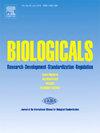Collaborative study on the cross-reactivity of two influenza B viral components in single radial immunodiffusion assay using quadrivalent influenza vaccines in Japan from 2015/16 to 2021–22 influenza season
IF 1.5
4区 生物学
Q4 BIOCHEMICAL RESEARCH METHODS
引用次数: 0
Abstract
A quadrivalent influenza vaccine (QIV) has been available in Japan since the 2015/2016 influenza season. Single radial immunodiffusion (SRID) assays are currently used worldwide to measure the hemagglutinin (HA) content of influenza vaccine components because they are simple, accurate, and the regulatory requirement, ensuring consistency in manufacture for the HA content. However, the cross-reactivity of antisera against the two lineages of the influenza B virus (IFVB) may cause inaccurate quantification of HA content in QIVs using the SRID assay. To examine cross-reactivity and develop an appropriate procedure for accurate measurement of vaccine potency, a collaborative study with four Japanese vaccine manufacturers was conducted to measure the HA contents of trivalent influenza vaccines (TIVs) and QIVs by SRID assay with a single and a mixture of reference antigens (refAgs) from each lineage of IFVB for seven influenza seasons from 2015/16 to 2021/22. The cross-reactivity of the two IFVB components in the SRID assay varied depending on the vaccine viruses. Our study demonstrated that it is useful to validate a suitable combination for each refAg and reference antiserum by selecting the combination showing similar HA contents between experimental TIV and QIV before lot release testing.
2015/16至2021/22流感季节日本使用四价流感疫苗进行的单径向免疫扩散测定中两种乙型流感病毒成分交叉反应的合作研究
日本自 2015/2016 年流感季节起开始使用四价流感疫苗 (QIV)。由于单径向免疫扩散(SRID)测定简单、准确,而且符合法规要求,可确保生产过程中 HA 含量的一致性,因此目前全世界都在使用这种方法来测定流感疫苗成分中的血凝素(HA)含量。然而,针对乙型流感病毒(IFVB)两个品系的抗血清的交叉反应可能会导致使用 SRID 检测法对 QIV 中 HA 含量的定量不准确。为了研究交叉反应并制定准确测量疫苗效力的适当程序,我们与四家日本疫苗生产商开展了一项合作研究,在 2015/16 年至 2021/22 年的七个流感季节中,使用 IFVB 各系的单一和混合参考抗原(refAgs),通过 SRID 分析法测量三价流感疫苗(TIV)和 QIV 的 HA 含量。在SRID检测中,两种IFVB成分的交叉反应因疫苗病毒而异。我们的研究表明,在批次放行测试之前,通过选择实验TIV和QIV之间HA含量相似的组合来验证每种参考抗血清和参考抗血清的合适组合是非常有用的。
本文章由计算机程序翻译,如有差异,请以英文原文为准。
求助全文
约1分钟内获得全文
求助全文
来源期刊

Biologicals
生物-生化研究方法
CiteScore
3.70
自引率
0.00%
发文量
39
审稿时长
48 days
期刊介绍:
Biologicals provides a modern and multidisciplinary international forum for news, debate, and original research on all aspects of biologicals used in human and veterinary medicine. The journal publishes original papers, reviews, and letters relevant to the development, production, quality control, and standardization of biological derived from both novel and established biotechnologies. Special issues are produced to reflect topics of particular international interest and concern.Three types of papers are welcome: original research reports, short papers, and review articles. The journal will also publish comments and letters to the editor, book reviews, meeting reports and information on regulatory issues.
 求助内容:
求助内容: 应助结果提醒方式:
应助结果提醒方式:


